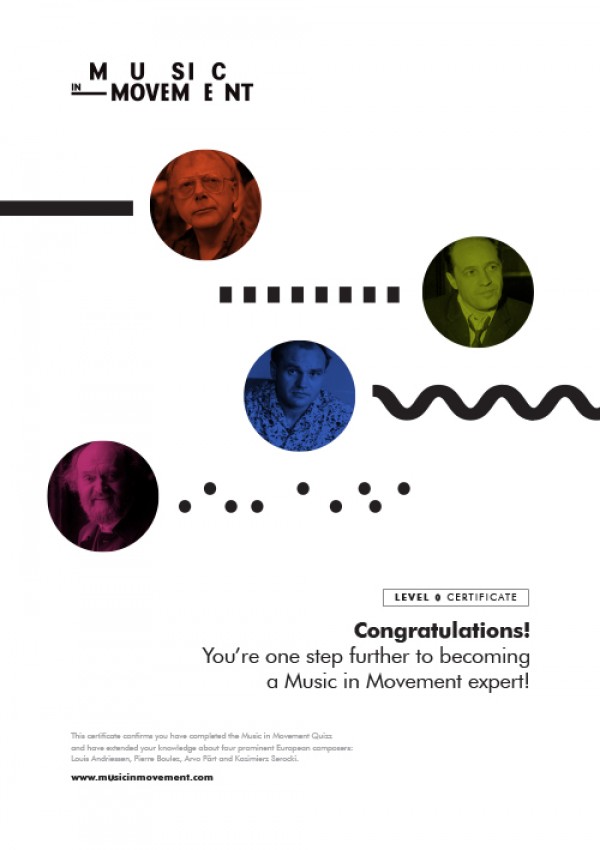MiM quiz – Explorer level / Education
Remember, this quiz is not about testing your knowledge about contemporary music. It's all about getting to know the four composers - their music, techniques, but also inspirations and private stories. We invite you to take on this challenge - discover the universe of four personalities and dive in into their music.
Vocal music - who composed this musical piece?
Listen to the short excerpt and recognize the composer.
The example comes from Pierre Boulez – Pli selon pli.
The example comes from Louis Andriessen La passione.
The example comes from Arvo Pärt – Kanon pokajanen.
The example comes from Kazimierz Serocki Poesies.
The four composers and film. To whom do the various descriptions apply?
Pierre Boulez’s music was not used in films as too complex, autonomous by nature and, consequently, not suited to illustrating anything.
Louis Andriessen liked to work with well-known directors (Peter Greenaway, Quay Brothers), although he did not write music “for films”, but, rather, co-created works with them in accordance with his own concept.
Arvo Pärt is one of those composers whose music is frequently used in films, choreographies, art and theatre projects,
Kazimierz Serocki’s film music legacy is substantial: from sound illustrations to documentaries to feature-length productions like Aleksander Ford’s The Teutonic Knights and Jerzy Hoffman's The Deluge.
Orchestral music - who composed this musical piece?
Listen to the short excerpt and recognize the composer.
Instrumental color scheme also plays a major role in Pli selon pli composed by Pierre Boulez, but this piece sounds quite different from Serocki’s music. Boulez saw the precise pitch as equally important as harmony arrangements.
In Ad libitum the nature of the music resembles that of colour fantasia, like in many of Krzysztof Serocki’s works.
A vivid, though by no means simple rhythm, sound of the orchestra favouring the brass rather than the strings suggest Louis Andriessen – the example is taken from his Mysterien.
Consonant chords, melody and harmony bringing to mind Renaissance music in Arvo Pärt’s 3. Symphony are characteristics of many of his works.
Chamber music - which of the four composers wrote this musical piece?
Listen to the short exceprt and recognise the composer.
The example comes from Louis Andriessen Zilver.
The example comes from Kazimierz Serocki Swinging Music.
The example comes from Arvo Pärt – Es sang vor langen Jahren.
The example comes from Pierre Boulez – Le marteau sans maître.
Scandals are part of the history of 20th-century music (in the 21st century scandals are not so easy to come by). Three of our four composers became protagonists of scandals for reasons listed below. Which composer is concerned in each case?
In 1945, in Paris Pierre Boulez with a group of young composer’s from Olivier Messiaen’s class organized a “charivari” during a performance of a neoclassical piece by Igor Stravinsky. For the young followers of dodecaphony the Russian composer was at that time an embodiment of regressive tendencies in music.
In 1969, in Amsterdam’s Concertgebouw young composers, with Louis Andriessen among them, sought to prevent Bernard Haitink from beginning a concert, protesting against the “undemocratic structure of the Concertgebouw Orchestra” and the lack of innovative contemporary works in its programmes
In 1968 Arvo Pärt’s Credo was performed in Tallinn – the piece featured the words “Credo in Jesum Christum” (I believe in Jesus Christ). The religious content of the piece outraged the Soviet authorities, as a result of which Pärt’s works were subsequently eliminated from the official concert repertoire and from the radio.
To which one of the four composers can the following quotes be attributed:
Not all of the quotations can be found on the MiM website, but the personalities and interests of the Composers clearly suggest the right answers.
Answer: Pierre Boulez
Not all of the quotations can be found on the MiM website, but the personalities and interests of the Composers clearly suggest the right answers.
Answer: Louis Andriessen
Not all of the quotations can be found on the MiM website, but the personalities and interests of the Composers clearly suggest the right answers
Answer: Kazimierz Serocki
Not all of the quotations can be found on the MiM website, but the personalities and interests of the Composers clearly suggest the right answers.
Answer: Arvo Pärt
Well done!
We hope you enjoyed the experience!
You can now share & save your MiM certificate!

